


Inspector Richard Queen wanted to know the identity of the
murdered man. How could he solve a murder mystery without knowing who was murdered? The
body was found in a private room of the Hotel Chancellor; no one connected with the
investigation had ever seen the man before. His name, where he came from, why he was
there, remain a mystery to the end. Yet all who were enmeshed in the web of the tragedy
found their lives changed by the death of the nameless nobody. A puzzling publishing murder attracts the eye of Ellery Queen. Mandarin Press is a premier publishing house for foreign literature, but to those at the top of this enterprise, there is little more beautiful than a rare stamp. As Donald Kirk, publisher and philatelist, prepares his office for a banquet, an unfamiliar man comes to call. No one recognizes him, but Kirk’s staff is used to strange characters visiting their boss, so Kirk’s secretary asks him to wait in the anteroom. Within an hour the mysterious visitor is dead on the floor, head bashed in with a fireplace poker, and everything in the anteroom has been quite literally turned upside down. The rug is backwards; the furniture is backwards; even the dead man’s clothes have been put on front-to-back. As debonair detective Ellery Queen pries into the secrets of Mandarin Press, every clue he finds is topsy-turvy. The great sleuth must tread lightly, for walking backwards is a surefire way to step off a cliff. |
| "Without doubt the best of the Queen stories." -- New York Times |
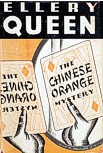 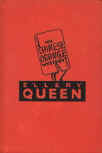   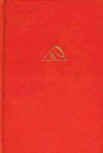 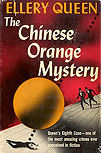  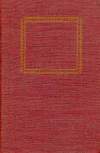 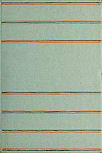 |
|
Above: The first books
published sometimes had identical front covers. The spine of the books/dust
cover only differ in the publisher's logo. Top row left to right: Both dust
cover and hard cover for Stokes, dust and hard cover for Grosset &
Dunlap. Bottom row left to right: cover International Readers League, dust cover for Triangle Books followed by three variations for the hard cover (Click on the covers to see the differences) * |
|
The Nassau Daily Review (Long Island),
"Pens and Margins" by Frank A. Culver -
July 10. 1934 "The perennial summer crop of murder-mystery novels proves itself to be in something of a hey-day with the appearance of the titles mentioned above. The Queen opus may be recommended as a puzzler to even the most seasoned readers of detective stories or experts in the deductive art of ratiocination. ... I may say here that I, by no means the most avid follower of mystery tales in this world, was sufficiently diverted to spend a good hour with this book. ... Here the author has gathered all the tricks and properties of the detective story proper, as well as some which must be new to the trade. There is, of course, the inevitable murder. But this is a unique thing in the way of detective story murders. The victim remains unidentified until the very last minute, so to speak; and since the solution of the plot deepens and the mystery thickens continuously up until the last half of the last chapter. I must admit that the solution of the mystery, once it is read, is a bit disappointing. At least, it seemed that way to me. I am a bit wary of detective stories, though, for that very reason. The endings, usually, make me feel as if I had been tricked. Such is the ending of "The Chinese Orange Mystery." The manipulations of Detective Queen seem Just a little reminiscent of those impossible and ridiculously intricate machines that Rube Goldberg invents in his cartoons. But then, after all, I know the solution of the mystery now; and you, my dear readers, do not. And if you submit yourselves to Mr. Queen's compelling enigma, I'll wager that you will be loath to quit the book until the solution, intricate as it is, is yours. That's the worth and the charm of detective stories, until you know what the solution is, it has a charm so wholly magnetic that the complication of incidents possesses itself of your whole consciousness. Suffice it to say that there are many plots and cross plots in this book ... and that before he has solved the mystery itself, the author has also solved several ghastly complications that threaten to disrupt things entirely. There are the usual alarming characters, a seductive adventuress, an irascible old gentleman, a sneaky-looking foreigner, and so on. And what is more, all the clues in the mystery seem to be backwards, so that the author's subtitle "A Study in Deduction" is a truism indeed. The very double meaning of the title is not revealed until the last chapter." Buffalo Evening News, - June 23. 1934 "Another Top-Notcher written by Ellery Queen. THOUSANDS of eager fans are awaiting the latest analytico-deductive problem from the author whose books appear in nine different languages, who has never written a failure, and whose most original and exciting thriller is this breathless tale of the unknown man whose body was found in a private room on the 22d floor of a hotel. His death shadowed the lives of seven prominent people, none of whom had ever seen or heard of him. The oddest thing of all was that the victim had his clothes on backward, and that everything in the room where the crime was committed — chairs, tables, even mirrors was turned the wrong way. And why had the mysterious stranger been eating a Chinese orange? Watch how Ellery Queen deducts the astounding solution by treading with infinite patience, through the pulsing tide of terror that sweeps lives and fortunes headlong be fore it." |
| The Chinese Orange Mystery (1934) has one of EQ's most baroque and inventive puzzles. It is none too realistic, and the storytelling sags badly between the murder and its solution, but its finale shows the tremendous imagination of the Golden Age mystery tale. It is similar to The Dutch Shoe Mystery in that it depends on a floor plan, but is even better as a complex plot. In some ways, it is the fulfillment of the promise of that early novel, one that blossoms out into full-fledged surrealism and splendor. Both books seem Chestertonian. Maybe this book is the most John Dickson Carr like of Queen's novels, and it is regarded as an experiment by its author in writing a John Dickson Carr book. However, a comparison of the dates suggests that it was written before Carr became "himself", and if there were influence here it would be in the other direction. The technique of the book is closely related to the "impossible crime", although EQ does not actually use it to create an impossible crime situation in the novel. Despite this, many historians of the locked room story seem to (falsely) remember it as a "locked room" book; it appeared on the poll of the top ten impossible crime books, for example, conducted by Edward D. Hoch for the Mystery Writers of America. This false memory is a remarkable case of collective amnesia. On a deeper level, the mystery writers who told Hoch that it was one of their favorite locked room stories were essentially right: it does come straight out of the impossible crime tradition. (Michael E.Grost) |
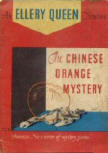 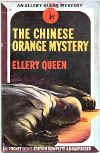 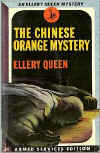  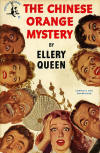     |
|
The nurse is named Diversey ; one wonders if this is in homage to
MacKinlay Kantor's first novel, Diversey (1928).
Hammett is also mentioned by name in this book. The suspects named
Macgowan (with a small g) could be a reference to Kenneth Macgowan
(as in
The Origin of Evil), who edited the
anthology
Sleuths (1931).
(Michael E.Grost)
|
  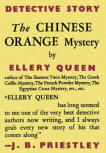 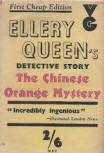 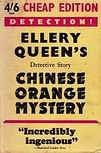 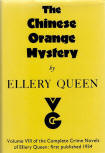 |
|
Ellery again with pince-nez, bachelor who has his own view on marriage.
He smokes cigarettes and uses an wooden stick. No mention of the Duesenberg. Movie (more or less): The Mandarin Mystery. |
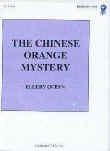  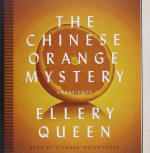 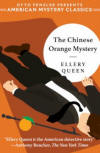  |
| Evening Star, "Among the stamp collectors"
by James Waldo Fawcett - Dec 15, 1940 "The Chinese Orange Mystery by Ellery Queen is another detective story featuring a murder committed for a postage stamp - a mythical treaty port error. Its author knows something about philately, but not much about the literary use of the English language. His style is a crime more intriguing than that which he attempts to solve." The Courier-Mail, Brisbane - August 25. 1934 - "Some Short Reviews of the Latest Books" "Murder mystery and sudden death are the everyday topics of that clever American writer, 'Ellery Queen,' who shares with his compatriot, S. S. Van Dine (the creator of 'Philo Vance), a wide English popularity. Ellery Queen, visiting the palatial flat of a millionaire friend, discovers a chance visitor not only murdered but the room completely disarranged and the victim's clothes on back to front. The whole setting- of the unusual and peculiar crime has an atmosphere of calculated evil that the author deftly manages to convey to the reader. However, Ellery Queen patiently works his way through half a dozen or so curious little sub-plots, and with characteristic aplomb unearths the real criminal." |
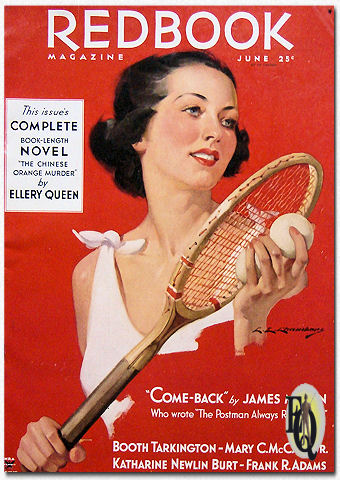 |
| Above: Issue of Redbook from June, 1934 with the complete book-size novel The Chinese Orange Murder. |

|
The Chinese Orange
Mystery Translations: |
|
Other articles on this book (1) Reading Ellery Queen Jon Mathewson (Feb 2014) (2) The Topsy-Turvy Murder Ho-Ling (May 16. 2013) (3) My Reader's Block Bev Hankins (Jan 13. 2011) |
|
*
Interested readers should know
that the icons/covers
of books, used throughout the
website have extra
descriptions/information not
included in the text on the same
page. Pointing your cursor at
the icon/cover used to reveal
this extra information. To achieve the same effect Firefox users can install an add-on called 'Popup ALT Attribute'. When installed pointing your cursor at an icon/cover results in showing you the details or additional information. |
|
Copyright © MCMXCIX-MMXXV Ellery Queen, a website on deduction. All rights reserved. |